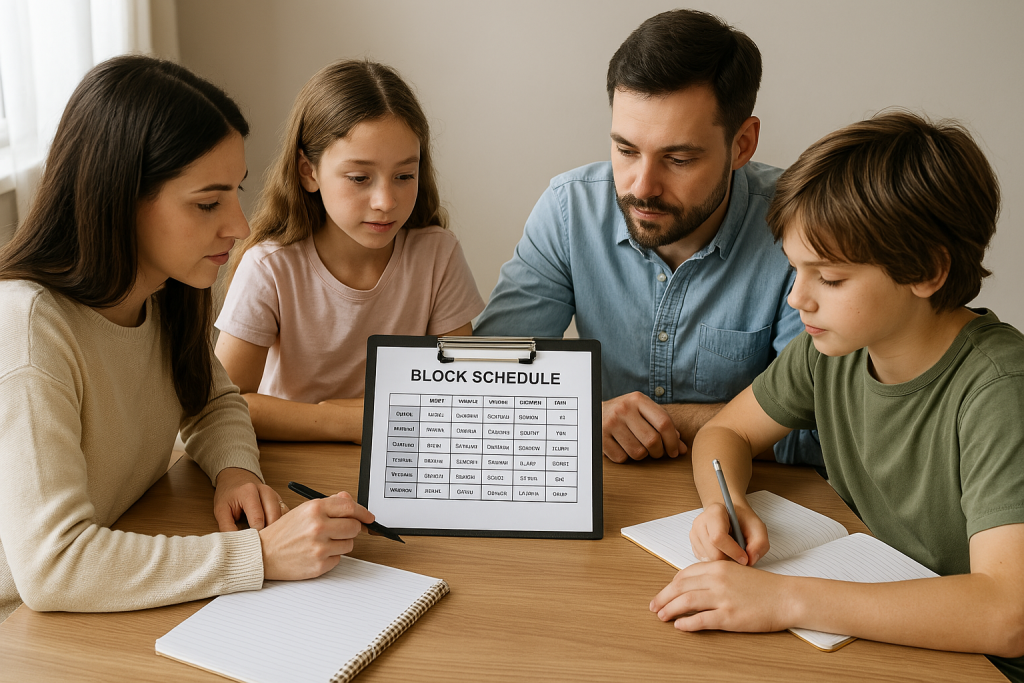Block scheduling is a time-management technique that organizes learning into larger blocks of time, typically 90 minutes to 2 hours, instead of the traditional 45-minute class periods.
This approach allows for in-depth exploration of subjects, hands-on activities, and a more flexible learning environment. Originally popularized in traditional schools, block scheduling has become a favorite method for homeschooling families looking to maximize their educational time without feeling rushed.
In this article, we’ll explain what block scheduling is, its benefits, different models, and how you can implement it in your homeschool routine.
The Basics of Block Scheduling
Traditional scheduling breaks the day into short periods where multiple subjects are taught. In contrast, block scheduling consolidates subjects into fewer but longer sessions. For example, instead of doing math for 45 minutes every day, a homeschool family might dedicate two 90-minute blocks per week to math. This longer time frame allows for more thorough instruction, hands-on projects, and deeper engagement with the material.
Benefits of Block Scheduling
Block scheduling offers several benefits for homeschooling families:
- Deep Focus on Subjects: Longer time periods allow students to fully immerse themselves in a subject without feeling rushed. This is particularly useful for subjects like science or history, where projects and experiments may take time.
- Reduced Transition Time: Transitioning between subjects can take time and interrupt the flow of learning. With block scheduling, students spend more time on each subject, reducing the number of transitions throughout the day.
- Flexibility in Learning Styles: If your child thrives on spending more time exploring a subject or has interests that benefit from hands-on activities, block scheduling offers the time needed for deeper learning and creativity.
- Customizable for Different Subjects: Not all subjects need to be taught daily. Subjects like art, music, or project-based learning can be slotted into longer blocks once or twice a week, freeing up time for core subjects like math and reading on other days.
Many researchers have dove into the effects of block schedule for children and older students. The impacts are phenomenal this peer-reviewed study published in the SagePub Journal explains that math students are able to feel better regarding the complexities of the topic and better retain difficult math concepts.
Types of Block Scheduling Models
There are a few common types of block scheduling models that homeschool families can adopt:
- Alternating Day Block Schedule: In this model, you alternate subjects on different days. For example, on Monday and Wednesday, you might focus on math and science, while Tuesday and Thursday are dedicated to reading and social studies. This allows for consistency without overloading students with too many subjects in one day.
- 4×4 Block Schedule: With this model, students take four subjects each semester and focus on them for longer periods each day. The next semester, they take four new subjects. This model is particularly beneficial for high school students, allowing them to concentrate on fewer subjects at a time while still completing a full course load by the end of the year.
- Modified Block Schedule: This flexible model allows you to mix longer blocks for some subjects and shorter periods for others. For instance, you might use a block for hands-on projects or complex subjects like science, while keeping shorter lessons for language arts.
Make sure to use our block scheduling easy PDF file to start your journey on the right foot! It’s completely free and a simple tool for you get block scheduling right.

For more information on creating an efficient homeschool schedule, visit our Homeschool Time Management Guide.
Implementing Block Scheduling in Homeschooling
To implement block scheduling in your homeschool, start by identifying your child’s needs and learning preferences. Do they prefer deep dives into fewer subjects, or do they thrive on variety? Next, map out your weekly schedule, blocking off time for core subjects as well as electives and activities. Here’s a simple example:
- Monday/Wednesday: 9:00 AM – 10:30 AM: Math, 11:00 AM – 12:30 PM: Science
- Tuesday/Thursday: 9:00 AM – 10:30 AM: Language Arts, 11:00 AM – 12:30 PM: History
- Friday: 9:00 AM – 10:30 AM: Art/Projects, 11:00 AM – 12:30 PM: Elective (Music, Foreign Language)
Feel free to modify this based on your child’s progress, interests, and energy levels. Flexibility is one of the greatest advantages of homeschooling.
For more details on creating a structured schedule, explore our Homeschool Routine Guide.
Block Scheduling for Different Age Groups
Block scheduling can be adapted to work for any age group. For younger children, shorter blocks (around 60 minutes) with plenty of breaks might work better. For older students, especially those in middle or high school, 90-minute blocks or even two-hour blocks can be more effective, allowing them to focus on more complex subjects like algebra or chemistry.
Elementary School Students
For younger children, shorter attention spans necessitate brief, focused learning periods. Implementing a modified block schedule with 30–45 minute sessions allows for concentrated instruction while accommodating the need for variety and movement. This approach can enhance engagement and retention. Research indicates that block scheduling may ease the transition from the self-contained classrooms of elementary schools to the more departmentalized structure of middle schools.
Middle School Students
As students mature, they can handle longer periods of focused study. Utilizing an alternating day block schedule (A/B schedule) with 60–90 minute classes can provide in-depth exploration of subjects while maintaining daily variety. Studies have shown that different scheduling systems in middle schools have both benefits and barriers related to academic achievement and subject flexibility.
High School Students
Older students often benefit from extended periods to delve deeply into complex subjects. The 4×4 block schedule, where students take four courses per semester with classes lasting about 90 minutes, allows for immersion in fewer subjects at a time. This model has been associated with higher GPAs, lower failure rates, and increased college enrollment.
What Is There To Like About Block Scheduling?
Block scheduling offers homeschooling families a powerful tool for managing time, enhancing learning, and customizing education to meet their child’s unique needs. Whether you’re working with younger children or high schoolers, block scheduling provides the flexibility and focus necessary for deep learning and efficient use of time.
Many families across the world have implemented that strategy to motivate their children as well as help them understand the necessities of structure even within a homeschooling environment. As a parent, being able to give your children structure and passion while learning can be greatly rewarding as it sets them up for life.

